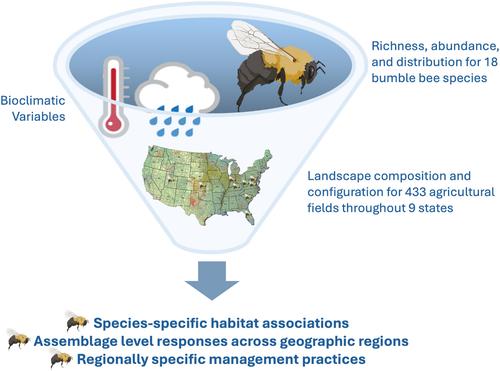当前位置:
X-MOL 学术
›
Glob. Change Biol.
›
论文详情
Our official English website, www.x-mol.net, welcomes your feedback! (Note: you will need to create a separate account there.)
Bumble bee responses to climate and landscapes: Investigating habitat associations and species assemblages across geographic regions in the United States of America
Global Change Biology ( IF 10.8 ) Pub Date : 2024-06-24 , DOI: 10.1111/gcb.17380 Morgan E. Christman 1, 2, 3 , Lori R. Spears 4 , Emily K. Burchfield 5 , William D. Pearse 6 , James P. Strange 3 , Ricardo A. Ramirez 1, 2, 7
Global Change Biology ( IF 10.8 ) Pub Date : 2024-06-24 , DOI: 10.1111/gcb.17380 Morgan E. Christman 1, 2, 3 , Lori R. Spears 4 , Emily K. Burchfield 5 , William D. Pearse 6 , James P. Strange 3 , Ricardo A. Ramirez 1, 2, 7
Affiliation

|
Bumble bees are integral pollinators of native and cultivated plant communities, but species are undergoing significant changes in range and abundance on a global scale. Climate change and land cover alteration are key drivers in pollinator declines; however, limited research has evaluated the cumulative effects of these factors on bumble bee assemblages. This study tests bumble bee assemblage (calculated as richness and abundance) responses to climate and land use by modeling species‐specific habitat requirements, and assemblage‐level responses across geographic regions. We integrated species richness, abundance, and distribution data for 18 bumble bee species with site‐specific bioclimatic, landscape composition, and landscape configuration data to evaluate the effects of multiple environmental stressors on bumble bee assemblages throughout 433 agricultural fields in Florida, Indiana, Kansas, Kentucky, Maryland, South Carolina, Utah, Virginia, and West Virginia from 2018 to 2020. Distinct east versus west groupings emerged when evaluating species‐specific habitat associations, prompting a detailed evaluation of bumble bee assemblages by geographic region. Maximum temperature of warmest month and precipitation of driest month had a positive impact on bumble bee assemblages in the Corn Belt/Appalachian/northeast, southeast, and northern plains regions, but a negative impact on the mountain region. Further, forest land cover surrounding agricultural fields was highlighted as supporting more rich and abundant bumble bee assemblages. Overall, climate and land use combine to drive bumble bee assemblages, but how those processes operate is idiosyncratic and spatially contingent across regions. From these findings, we suggested regionally specific management practices to best support rich and abundant bumble bee assemblages in agroecosystems. Results from this study contribute to a better understanding of climate and landscape factors affecting bumble bees and their habitats throughout the United States.
中文翻译:

熊蜂对气候和景观的反应:调查美国不同地理区域的栖息地关联和物种组合
熊蜂是本地和栽培植物群落不可或缺的传粉媒介,但物种在全球范围内的范围和丰度正在发生重大变化。气候变化和土地覆盖变化是传粉媒介减少的关键驱动因素;然而,有限的研究评估了这些因素对大黄蜂群的累积影响。本研究通过模拟特定物种的栖息地要求以及跨地理区域的群体水平响应来测试熊蜂群体(以丰富度和丰度计算)对气候和土地利用的响应。我们将 18 种熊蜂物种的物种丰富度、丰度和分布数据与特定地点的生物气候、景观组成和景观配置数据相结合,以评估多种环境压力因素对佛罗里达州、印第安纳州、堪萨斯州 433 个农田中熊蜂群落的影响2018 年至 2020 年,肯塔基州、马里兰州、南卡罗来纳州、犹他州、弗吉尼亚州和西弗吉尼亚州。在评估物种特定栖息地关联时,出现了独特的东西方分组,促使对按地理区域划分的熊蜂组合进行详细评估。最暖月最高气温和最干月降水对玉米带/阿巴拉契亚/东北部、东南部和北部平原地区的熊蜂群落有积极影响,但对山区有消极影响。此外,农田周围的林地覆盖被强调为支持更丰富的熊蜂群。总体而言,气候和土地利用共同推动了大黄蜂的聚集,但这些过程的运作方式在不同地区具有特殊性和空间偶然性。 根据这些发现,我们提出了针对特定区域的管理实践,以最好地支持农业生态系统中丰富的熊蜂群。这项研究的结果有助于更好地了解影响美国熊蜂及其栖息地的气候和景观因素。
更新日期:2024-06-24
中文翻译:

熊蜂对气候和景观的反应:调查美国不同地理区域的栖息地关联和物种组合
熊蜂是本地和栽培植物群落不可或缺的传粉媒介,但物种在全球范围内的范围和丰度正在发生重大变化。气候变化和土地覆盖变化是传粉媒介减少的关键驱动因素;然而,有限的研究评估了这些因素对大黄蜂群的累积影响。本研究通过模拟特定物种的栖息地要求以及跨地理区域的群体水平响应来测试熊蜂群体(以丰富度和丰度计算)对气候和土地利用的响应。我们将 18 种熊蜂物种的物种丰富度、丰度和分布数据与特定地点的生物气候、景观组成和景观配置数据相结合,以评估多种环境压力因素对佛罗里达州、印第安纳州、堪萨斯州 433 个农田中熊蜂群落的影响2018 年至 2020 年,肯塔基州、马里兰州、南卡罗来纳州、犹他州、弗吉尼亚州和西弗吉尼亚州。在评估物种特定栖息地关联时,出现了独特的东西方分组,促使对按地理区域划分的熊蜂组合进行详细评估。最暖月最高气温和最干月降水对玉米带/阿巴拉契亚/东北部、东南部和北部平原地区的熊蜂群落有积极影响,但对山区有消极影响。此外,农田周围的林地覆盖被强调为支持更丰富的熊蜂群。总体而言,气候和土地利用共同推动了大黄蜂的聚集,但这些过程的运作方式在不同地区具有特殊性和空间偶然性。 根据这些发现,我们提出了针对特定区域的管理实践,以最好地支持农业生态系统中丰富的熊蜂群。这项研究的结果有助于更好地了解影响美国熊蜂及其栖息地的气候和景观因素。











































 京公网安备 11010802027423号
京公网安备 11010802027423号